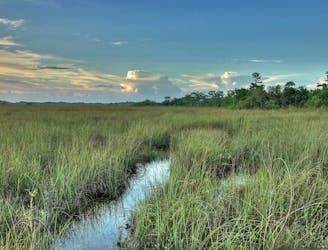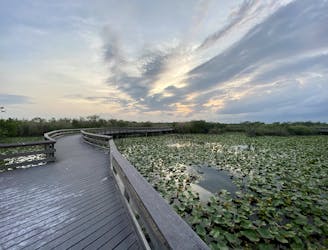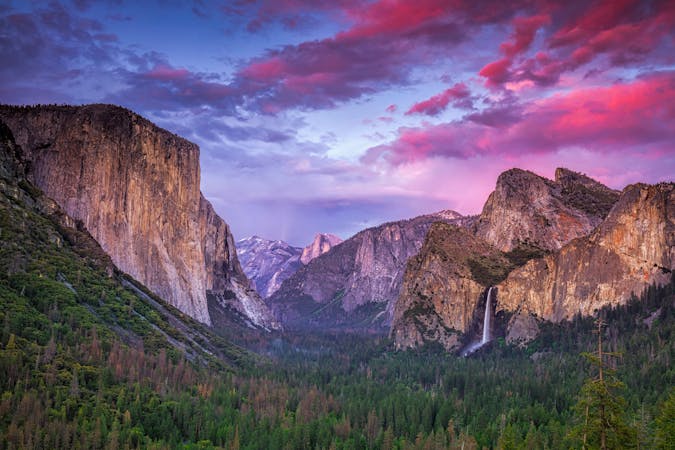Long Pine Key Nature Trail

Bike or walk a two-track path through sunny pine forest and open fields, near Long Pine Key Campground.
Easy Gravel Biking
- Distance
- 9.8 km
- Ascent
- 3 m
- Descent
- 3 m

Explore the best foot trails through the wildlife-rich wetlands of Everglades National Park.
Gravel Biking, Hiking Easy, Moderate, Difficult

The wilderness of South Florida is a famous, but misunderstood and imperiled ecosystem. At the mention of the Everglades, most people envision a grassy quagmire ridden with dangerous reptiles. Such a place is deemed useless to the human notion of progress, so much of the glades have been drained, diverted, or filled to serve the cities of Florida.
Luckily, within the past century people have realized the true value of this ecosystem. The vast wetlands, however inhospitable, are indispensable for natural flood control, biodiversity, carbon sequestration, and more. The glades even reveal an exquisite beauty to those who care to look. Only by venturing into the Everglades can one find what makes them really worth conserving.
There is, of course, the sawgrass marsh––a “river of grass” where vast amounts of water slide from inland Florida slowly toward the sea. But there’s more to the landscape than that. There are also semi-dry grasslands, cypress swamps, pine-dotted uplands, jungle-like thickets, mangrove shores, and sandy beaches. Each of these habitats uniquely serves the ecosystem, which is home to some of the nation’s rarest wildlife like the American crocodile and the Florida panther, plus birds found nowhere else on the mainland.
Because so much of the park is water, it’s impossible to fully appreciate without traveling by boat, but hiking is available. Most land trails are short and built up to cope with flooding. There are a few longer ones, though, and some can make a decent backpacking trip. Those longer hikes are described in this guidebook, as are some shorter must-dos.
Keep in mind that the park has three entrances that do not connect by road. Luckily, most of the hiking trails (and all the trails covered here) are inside the Ernest F. Coe entrance near Homestead, Florida. The other entrances are better for different kinds of adventures. The Shark Valley entrance has a paved loop which is best for biking, while the Gulf Coast entrance has the Wilderness Waterway for canoeing and kayaking.
The best season for the Everglades is generally winter, especially if hiking is the main intent. That’s when temperatures are most pleasant and rain is least frequent. Humidity and bugs also lessen significantly in winter. As one might imagine, these nuisances tend to worsen as the weather warms, making midsummer the least ideal time for the Everglades. Plenty of people still visit in summer, but it’s best to stick to short trails where shelter and air conditioning are never far away. Winter has the added bonus of better wildlife viewing as well. That’s because it’s the dry season, when the wetlands shrink down, and aquatic species condense. Birds congregate around the food supply, and additional species migrate in for the winter. Foot travel through the Everglades may be limited, but the following trails provide the best avenues for finding this wildlife and experiencing the diverse habitats of Everglades National Park.

Bike or walk a two-track path through sunny pine forest and open fields, near Long Pine Key Campground.
Easy Gravel Biking

Remote paths through a wilderness area, among diverse vegetation and excellent wildlife habitat.
Moderate Hiking

Hike through inhospitable habitats to camp on a wilderness beach at the far southern tip of mainland Florida.
Difficult Hiking

Walk through coastal prairie and tropical forest that are unique to this far-south tip of Florida.
Easy Hiking

This hiking and biking trail extends miles into the Everglades’ formidable swamps, but stays high and (mostly) dry on a historic roadbed.
Easy Hiking

One of the best walks in the Everglades for viewing resident wildlife.
Easy Hiking

63 routes · Alpine Climbing · Hiking